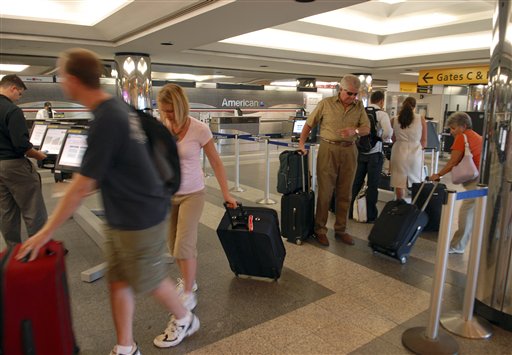
An electronic communication failure Tuesday at a Federal
Aviation Administration facility in Georgia that processes flight
plans for the eastern half of the U.S. was causing hundreds of
flight delays around the country.
An electronic communication failure Tuesday at a Federal Aviation Administration facility in Georgia that processes flight plans for the eastern half of the U.S. was causing hundreds of flight delays around the country.
An FAA Web site that tracks airport status showed delays at some three dozen major airports across the country. The site advised passengers to “check your departure airport to see if your flight may be affected.”
FAA spokeswoman Kathleen Bergen in Atlanta said there were no safety issues and officials were still able to speak to pilots on planes on the ground and in the air.
She said she did not know exactly how many flights were being affected, but she said it was in the hundreds. She added that officials might not have total figures until Wednesday. Bergen said that in a 24-hour period the FAA processes more than 300,000 flight plans in the U.S.
Bergen said the problem that occurred Tuesday afternoon involved an FAA facility in Hampton, Ga., south of Atlanta, that processes flight plans. She said there was a failure in a communication link that transmits the data to a similar facility in Salt Lake City.
As a result, the Salt Lake City facility was having to process those flight plans, causing delays in planes taking off. She said there were no problems landing for planes that were already in the air.
“There will be flight delays,” Bergen said. “It could be any location, because one facility is now processing flight data for everybody.”
Bergen said there was an unrelated hardware problem at the Hampton facility on Aug. 21 that resulted in issues processing flight plans, but she was unsure if there were any flight delays.
A spokesman for Hartsfield-Jackson Atlanta International Airport, the world’s busiest airport, did not immediately return a call seeking comment on the impact there from Tuesday’s episode. Bergen said officials at the Atlanta airport were entering flight data manually to try to speed things up.
Discount carrier AirTran Airways, which has its hub at the Atlanta airport, said in a statement that because of the suburban FAA center snafu it was taking up to an hour for the FAA to get clearances to the towers for departures. Delta Air Lines Inc., which has its main hub in Atlanta, said flights were processing for takeoff, but slowly.
The communication failure was causing delays for departures and arrivals at Baltimore-Washington International Thurgood Marshall Airport, according to airport spokeswoman Cheryl Stewart. However, she did not have a number on delays.
The FAA has asked that no new flight plans be filed, Stewart said. If an airline has not filed a flight plan yet, that flight cannot leave. However, some flights had already filed their plans and those planes were being allowed to depart, Stewart said.
Phil Orlandella, a spokesman for Massport, which operates Boston’s Logan International Airport, said “there are significant delays, both inbound and outbound.” He declined to comment further. Bergen explained that if a plane was heading from Atlanta to Boston, for instance, and it was being held on the ground in Atlanta, it would be delayed arriving in Boston.
Carolyn Fennell, spokeswoman for the Orlando International Airport, said 13 Southwest Airlines flights had been affected by the glitch.
Brenda Geoghagan, a spokeswoman for Tampa International Airport in Florida, said “it may just be too soon” to determine the impact there. Christine Osborn, another spokeswoman at the Tampa airport, said there have been no delays due to the flight plan communication failure. But she said she anticipates problems in the coming hours.
“There’s definitely going to be some impact,” she said.
At Miami International Airport, there were no delays or cancelations due to the communication failure, said spokesman Marc Henderson.
“There are cancelations due to weather from the hurricane, but not due to this,” he said.
The National Airspace Data Interchange Network is a data communications system for air traffic controllers. It’s used to distribute flight plans and allows controllers to know when planes are leaving, where they’re going and other details.
Allen Kenitzer, a western regional spokesman for the FAA, said the Utah system could handle the extra load while workers tried to get the Atlanta system back online, but it was expected to slow down air traffic.
“We’re not going to let an unsafe condition exist. It’s just going to be slower,” Kenitzer said.









